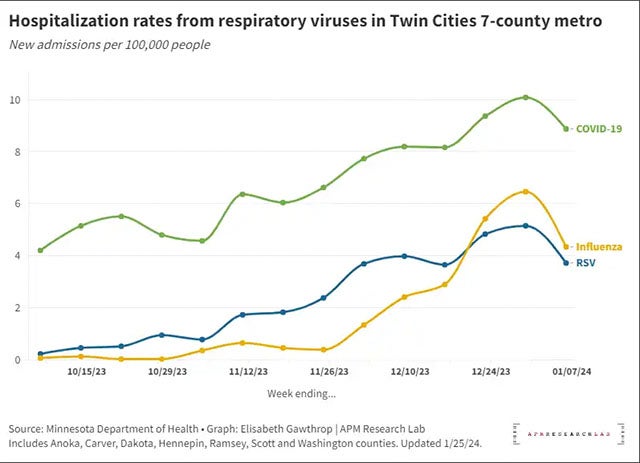Hopeful downticks in Minnesota’s COVID-19, RSV and flu data
Published 3:39 pm Friday, January 26, 2024

- The Minnesota Department of Health's latest data shows declines in all three major respiratory illnesses after weeks of increases. Elisabeth Gawthrop/APM Research Lab
|
Getting your Trinity Audio player ready...
|
By Craig Helmstetter, Minnesota Public Radio News
While just one new week’s worth of data does not indicate a clear trend, it is worth noting when that one week may signal a change. Especially if it is a hopeful one, as suggested in the downticks in all three major respiratory illnesses currently active in the state: COVID-19, Respiratory Syncytial Virus (RSV) and influenza.
Two weeks ago, MPR News reported all three diseases were surging. Thankfully, that no longer appears to be the case in Minnesota.
In the Twin Cities seven-county metro, the number of new hospital admissions for COVID-19, flu and RSV are down by 12 percent, 33 percent and 28 percent, respectively, for the first week in January compared to the last week in December.
While rates for all three could go back up, flu and RSV are seasonal and may have hit their peaks. If that is the case, this year’s peaks were lower than last year’s.
According to Minnesota Department of Health data, weekly flu hospitalizations this year could have peaked at 6.46 per 100,000 compared to a peak of 12.04 last year, and RSV hospitalizations possibly peaked at 5.15 per 100,000 Minnesotans this year compared to last year’s peak of 5.97 per 100,000.
For RSV, the more relevant year-to-year peak comparison is for those most susceptible, those ages 0 to 4. Among that group, just over 50 per 100,000 were hospitalized with RSV during this year’s peak (to date), compared to last year’s much earlier and larger peak of over 73 per 100,00 for that same age group.
COVID-19 hospitalizations are declining as are COVID levels measured in wastewater
It is even less certain that COVID-19 activity in Minnesota has reached any sort of peak, since COVID-19 is not particularly seasonal.
It is, however, hopeful to see the number of hospitalizations decline after more than two months of consistent increases in that metric.
The decline in hospital admissions is reflected in recent declines in COVID-19 levels measured in the state’s wastewater.
According to the University of Minnesota’s on-going Wastewater Surveillance Study, the most recent statewide wastewater levels as of Jan. 17 are down by 22 percent compared to the week prior. And this follows a 15 percent weekly decline reported in the previous week’s data.
Only the study’s North East region, which includes data from wastewater plants in Crow Wing, Koochiching, Pine and St. Louis counties, shows an increase in COVID-19 levels in this latest data. However, COVID-19 levels are down in every region, including the North East, over a longer four-week comparison.
COVID-19 vaccination rate up only slightly
Finally, one other COVID-19 metric is up — but only slightly. The Minnesota Department of Health’s latest monthly update on COVID-19 vaccination rates shows that 19.5 percent of Minnesotans have now taken advantage of the latest formulation of COVID-19 vaccine, which was approved in Sept. 2023. This is up by less than two percentage points from the vaccination rate reported in December.
A relatively small minority of Minnesotans in most age groups are up to date on their COVID-19 vaccination. A majority (56 percent) of those age 65 or older in the state are up to date.
Olmsted and Cook counties, home to Rochester and Grand Marias respectively, are tied for the state’s highest COVID-19 vaccination rate, each at 31 percent. On the other end of the spectrum, less than eight percent of the residents of Roseau County, in far northern Minnesota, are up to date on the latest COVID-19 vaccine.
According to national data from the Centers for Disease Control and Prevention, Minnesota has the nation’s third highest adult COVID-19 vaccination rate (35 percent), behind only Vermont (47 percent) and Washington, D.C. (42 percent).





